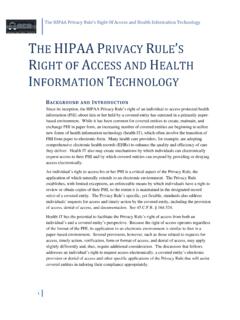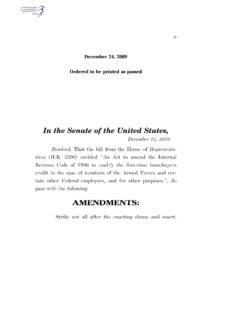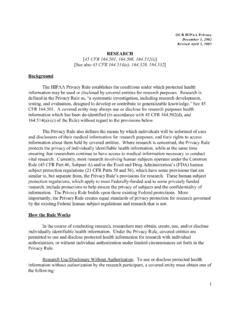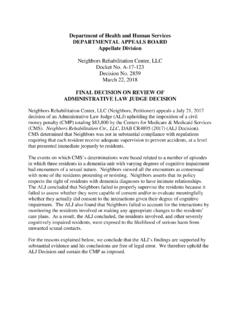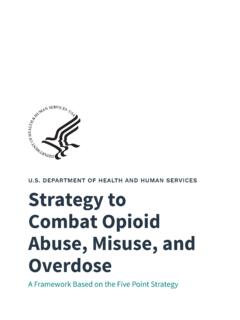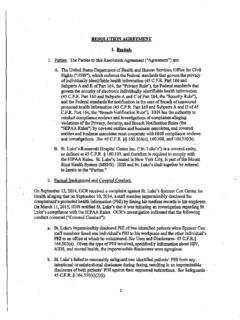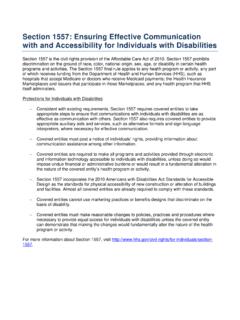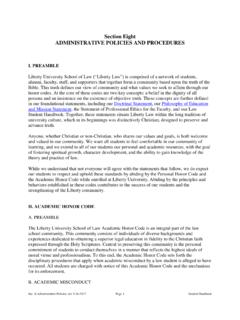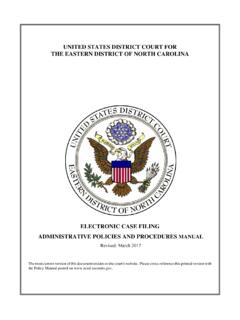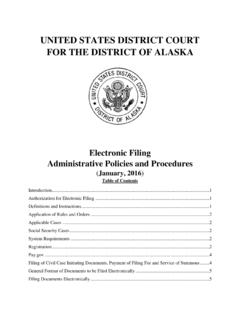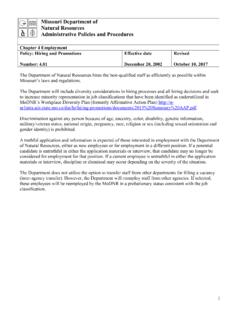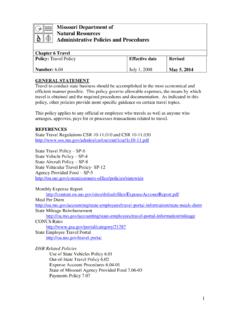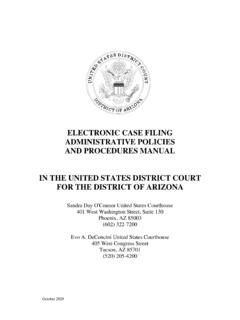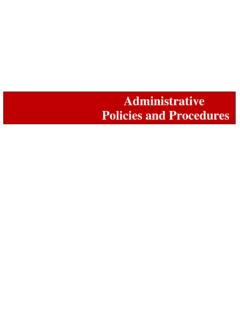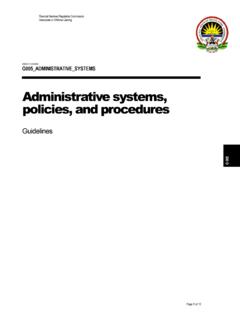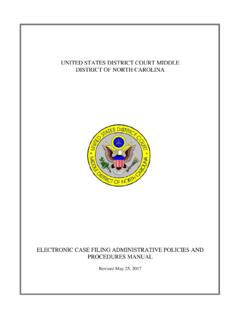Transcription of HIPAA Security Series #2 - Administrative Safeguards
1 Volume 2 / Paper 2 15/2005: rev. 3/2007 HIPAAS ecuritySERIES Compliance Deadlines No later than April 20, 2005 for all covered entities except small health plans, which have until no later than April 20, 2006. NOTE: To download the first paper in this Series , Security 101 for Covered Entities, visit the CMS website at: the Regulation page. What is the Security Series ? The Security Series of papers will provide guidance from the Centers for Medicare & Medicaid Services (CMS) on the rule titled Security Standards for the Protection of Electronic Protected Health Information, found at 45 CFR Part 160 and Part 164, Subparts A and C, commonly known as the Security Rule. The Security Rule was adopted to implement provisions of the Health Insurance Portability and Accountability Act of 1996 ( HIPAA ). The Series will contain seven papers, each focused on a specific topic related to the Security Rule. The papers, which cover the topics listed to the left, are designed to give HIPAA covered entities insight into the Security Rule and assistance with implementation of the Security standards.
2 This Series explains specific requirements, the thought process behind those requirements, and possible ways to address the provisions. CMS recommends that covered entities read the first paper in this Series , Security 101 for Covered Entities before reading the other papers. The first paper clarifies important Security Rule concepts that will help covered entities as they plan for implementation. This second paper in the Series is devoted to the standards for Administrative Safeguards and their implementation specifications and assumes the reader has a basic understanding of the Security Rule. Background An important step in protecting electronic protected health information (EPHI) is to implement reasonable and appropriate Administrative Safeguards that establish the foundation for a covered entity s Security program. The Administrative Safeguards standards in the Security Rule, at , were developed to accomplish this Standards: Administrative SafeguardsSecurity Topics 5.
3 Security Standards - Organizational, policies & procedures , and Documentation Requirements 4. Security Standards - Technical Safeguards 3. Security Standards - Physical Safeguards 1. Security 101 for Covered Entities 6. Basics of Risk Analysis and Risk Management 7. Implementation for the Small Provider 2. Security Standards - Administrative Safeguards 5. Security Standards - Organizational, policies and procedures and Documentation Requirements 2 Security Standards: Administrative Safeguards Volume 2 / Paper 2 25/2005: rev. 3/2007 The objectives of this paper are to: Review each Administrative Safeguards standard and implementation specification listed in the Security Rule. Discuss the purpose for each standard. Provide sample questions that covered entities may want to consider when implementing the Administrative Safeguards . Sample questions provided in this paper, and other HIPAA Security Series papers, are for consideration only and are not required for implementation.
4 The purpose of the sample questions is to promote review of a covered entity s environment in relation to the requirements of the Security Rule. The sample questions are not HHS interpretations of the requirements of the Security Rule. All the information presented in the Security Series is designed to further covered entities understanding of the Security Rule concepts. The papers are not intended to be the definitive guidance for covered entity compliance. Compliance with the Security Rule will depend on a number of factors, including those identified in (b)(2): (i) The size, complexity, and capabilities of the covered entity. (ii) The covered entity's technical infrastructure, hardware, and software Security capabilities. (iii) The costs of Security measures. (iv) The probability and criticality of potential risks to EPHI. What are Administrative Safeguards ? The Security Rule defines Administrative Safeguards as, Administrative actions, and policies and procedures , to manage the selection, development, implementation, and maintenance of Security measures to protect electronic protected health information and to manage the conduct of the covered entity s workforce in relation to the protection of that information.
5 The Administrative Safeguards comprise over halfof the HIPAA Security requirements. As with all the standards in this rule, compliance with the Administrative Safeguards standards will require an evaluation of the STANDARD (a)(1) Administrative Safeguards - Security Management Process -Assigned Security Responsibility -Workforce Security -Information Access Management - Security Awareness and Training - Security Incident procedures -Contingency Plan -Evaluation -Business Associate Contracts and Other Arrangements HIPAA Security STANDARDS PHYSICAL Safeguards -Facility Access Controls -Workstation Use -Workstation Security -Device and Media Controls TECHNICAL Safeguards -Access Control -Audit Controls -Integrity -Person or Entity Authentication - Transmission Security ORGANIZATIONALREQUIREMENTS-Business Associate Contracts and Other Arrangements -Requirements for Group Health PlansSecurity Standards: General Rules policies and procedures and DOCUMENTATIONREQUIREMENTS2 Security Standards.
6 Administrative Safeguards Volume 2 / Paper 2 35/2005: rev. 3/2007 STANDARD (a)(1)NOTE: For a more detailed discussion of addressable and required implementation specifications, see the first paper in this Series , Security 101 for Covered Entities. Security controls already in place, an accurate and thorough risk analysis, and a Series of documented solutions derived from a number of factors unique to each covered entity. Security Management Process The first standard under Administrative Safeguards section is the Security Management Process. This standard requires covered entities to: Implement policies and procedures to prevent, detect, contain and correct Security violations. The purpose of this standard is to establish the Administrative processes and procedures that a covered entity will use to implement the Security program in its environment. There are four implementation specifications in the Security Management Process standard.
7 1. Risk Analysis (Required) 2. Risk Management (Required) 3. Sanction Policy (Required) 4. Information System Activity Review (Required) The Importance of Risk Analysis and Risk Management Risk analysis and risk management are critical to a covered entity s Security Rule compliance efforts. Both are standard information Security processes that have already been adopted by some organizations within the health care industry. As stated in the responses to public comment in the preamble to the Security Rule, the Security Management Process standard and associated implementation specifications form the foundation upon which an entity s necessary Security activities are built. The results from the risk analysis and risk management processes will become the baseline for Security processes within covered entities. This paper provides a general understanding of risk analysis and risk management concepts and processes. CMS will include a more detailed discussion of risk analysis and risk management in paper 6 in the HIPAA Security Series titled, Basics of Risk Analysis and Risk Management.
8 NOTE: Risk analysis and risk management serve as tools to assist in the development of a covered entity s strategy to protect the confidentiality, integrity, and availability of EPHI. 2 Security Standards: Administrative Safeguards Volume 2 / Paper 2 45/2005: rev. 3/2007 1. RISK ANALYSIS (R) - (a)(1)(ii)(A) The Risk Analysis implementation specification requires covered entities to: Conduct an accurate and thorough assessment of the potential risks and vulnerabilities to the confidentiality, integrity, and availability of electronic protected health information held by the covered entity. In general, a risk analysis can be viewed as: The process of identifying potential Security risks, and Determining the probability of occurrence and magnitude of risks. Sample questions for covered entities to consider: How does EPHI flow throughout the organization? This includes EPHI that is created, received, maintained or transmitted by the covered entity.
9 What are the less obvious sources of EPHI? Has the organization considered portable devices like PDAs? What are the external sources of EPHI? For example, do vendors or consultants create, receive, maintain or transmit EPHI? What are the human, natural, and environmental threats to information systems that contain EPHI? 2. RISK MANAGEMENT (R) - (a)(1)(ii)(B) Risk Management is a required implementation specification. It requires an organization to make decisions about how to address Security risks and vulnerabilities. The Risk Management implementation specification states that covered entities must: Implement Security measures sufficient to reduce risks and vulnerabilities to a reasonable and appropriate level to comply with (a). Risk management is the process used to identify and implement Security measures to reduce risk to a reasonable and appropriate level within the covered entity based on the covered entity s circumstances. The measures implemented to comply with this required implementation specification must also allow the covered entity to comply with 2 Security Standards: Administrative Safeguards Volume 2 / Paper 2 55/2005: rev.
10 3/2007 (a) of the Security Standards: General Rules. Covered entities will want to answer some basic questions when planning their risk management process. Sample questions for covered entities to consider: What Security measures are already in place to protect EPHI ( , Safeguards )? Is executive leadership and/or management involved in risk management and mitigation decisions? Are Security processes being communicated throughout the organization? Does the covered entity need to engage other resources to assist in risk management? In general, a covered entity will want to make sure its risk management strategy takes into account the characteristics of its environment including the factors at (b)(2), which are listed on page 2 of this paper. These factors will help the covered entity to determine what potential Security measures are reasonable and appropriate for its environment. 3. SANCTION POLICY (R) - (a)(1)(ii)(C) Another implementation specification in the Security Management Process is the Sanction Policy.
